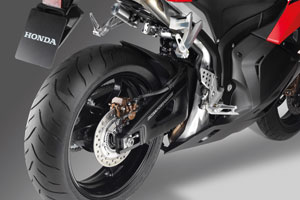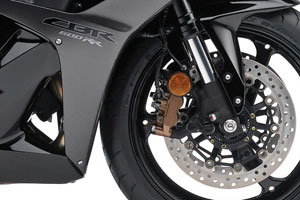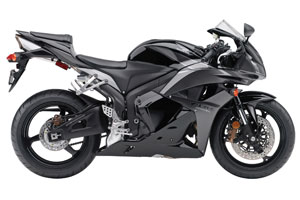MotoOnline.com.au takes Honda’s 2009 model e-CABS braking equipped CBR600RR for a spin at the Creek.

How does e-CABS work?
Honda has developed the electronically-controlled Combined Anti-Lock Braking System (e-CABS) for its CBR1000RR and CBR600RR sportsbikes so that the system will allow riders to brake at extreme levels without the system kicking in until extremely necessary.
The e-CABS must allow the rider to brake very close to the limit before activating, and when it does, the reduction in braking force must be very smooth in order not to unsettle the machine, or rider.
Honda found out in testing, both on the road and racetrack, that development riders found the system exceeds their demands and outperforms the rider’s ability to brake on most occasions.
An average (non-expert) rider using a conventional braking system needs several braking attempts to attain braking performance approaching that of the e-CABS. An expert rider using a conventional system will need fewer attempts to reach a similar level.
However, only in an example such as a racetrack situation, where an expert rider repeatedly brakes into the same corner was it found that the tester could outperform the e-CABS.
Check out the video in at the bottom of the screen to see how e-CABS works exactly.
Specifications
ENGINE
Engine type: 599cc liquid-cooled 4-stroke 16-valve DOHC inline-4
Bore x stroke: 67 x 42.5mm
Displacement: 599cc
Compression ratio: 12.2:1
Transmission: Six speed
Power (claimed): Not given
Torque (claimed): Not given
CHASSIS
Frame type: Fine Die-Cast
Front suspension: 41mm fully adjustable inverted HMAS cartridge type telescopic fork
Rear suspension: Unit Pro-Link with gas charged remote reservoir damper, adjustable spring preload and compression and rebound damping
Wheelbase: 1375mm
Wheels (front/rear): Not given
Tyres (front/rear): 120/70-17 / 180/55-17
Brakes (front/rear): e-CABS 2 x 310mm hydraulic disc with radial mount 4-piston callipers, floating rotors and sintered metal pads / e-CABS 1 x 220mm hydraulic disc with single-piston calliper and sintered metal pads
DIMENSIONS
Weight (claimed): 194kg (184kg without e-CABS)
Seat height: 820mm
Fuel capacity: 18L
PURCHASE DETAILS
Price: $16,990 ($15,990 without e-CABS)
Colour options: Graphite Black/Italian Red; Graphite Black/Silver; Black/Green (standard model only)
Test bike from: Honda Australia (www.hondamotorcycles.com.au)
When Honda announced that it would be releasing its leading sportsbikes with an Anti-lock Braking System (ABS) in 2009, you could be forgiven for wondering what benefits ABS would provide on a sportsbike.
In this day and age most technical advancements on high performance production bikes trickle down from MotoGP or Superbike racing, but I haven’t exactly seen an ABS set-up mounted to the side of either Dani Pedrosa or Jonathan Rea’s factory Honda race bikes lately.
But never mind, because after a few sessions out at Eastern Creek Raceway on Honda’s latest CBR600RR it becomes obvious that ABS is a great benefit in some circumstances on the track at least.
The new CBR600RR is available with the new e-CABS (what Honda calls electronically-controlled Combined Anti-lock Braking System) brakes or without, and the option with the e-CABS retails for $16,990 compared with the standard version’s price of $15,990.
For that extra $1000 you get an extra 10 kilograms, which is how much weight the e-CABS adds to the overall weight of the 600 double-r.
Using the system on track provides a whole new dimension of sportsbike riding on the race track as the bike has absolutely no signs of rear wheel locking on any corner entrances.
Gone are my habits of jumping on a heap of rear brake to slow the bike down in a sideways manoeuvre on corner entry, and now I find myself able to push the rear brake lever harder than ever before without locking the rear tyre and skating into the turn.
While the rear brake offers ample improvement for me in regards to both braking power and control, the front lever takes a little more effort to feel 100 percent comfortable with.
Honda states that the e-CABS isn’t exactly designed to be a performance enhancement for riding at maximum pace on the race track, the system is a valuable assistance in many areas of circuit riding.
Braking while keeping the bike upright is a massive improvement, although the front lever feel isn’t quite as precise as the feel on a regular braking system. It doesn’t have the absolute bite on first squeeze that non-ABS brakes do, but you can apply them much harder on both front and rear without the concern that they could lock at any moment.
Apart from the decreased lever feel, the only other major aspect to get used to is the feeling when trail-braking as you begin to lean the bike into the turn. It feels as though the bike wants to remain upright a little more than the standard model, which is likely because you’re able to brake later and deeper into the turn.
It really is a case of developing a feel for the e-CABS system, and I’ve got a feeling that for track day riders, once you switch to anti-lock braking it will be hard to return to regular brakes. Same goes for street riders.
Racing is a different story, though, as the more aggressive nature of racing requires as much general feel and feedback that you can get, so I think it will be a little while yet before we see the system implemented on team Honda’s bikes in any major series.
In saying that, wet weather racing could see some real advantages for the Honda-mounted riders if the opt for the ABS system, and I believe that the e-CABS on the Honda might just allow riders to brake much harder in rainy conditions even in racing conditions.
While we haven’t sampled the e-CABS on the road yet, that’s where the major benefits are going to be felt in both dry and wet conditions, and this is where Honda is going to please many of its loyal customers.
Tests worldwide have seen the braking allow riders to apply the brakes in the wet in a much smoother and harder manner, which is a huge improvement for motorcycle safety on sportsbikes.
The same could be said for riding in the dry on the road, with braking power and precision very much magnified in an emergency situation – like if a car pulls out in front of you, for example.
Only subtle refinements have been made to this year’s CBR600RR apart from offering the ABS version, with the radially-mounted four-piston calipers that squeeze the pads onto the 310mm front brake disks featuring a new monoblock set-up. At the rear, a 220mm disc is gripped by a single-piston caliper.
The styling features a new undercowl on the fairings that covers up a lot more of the engine, although my personal preference was for the older version that allowed you to see more of the engine. Minor design changes and new air vents are also added to create a more effective airflow at medium and high speeds for better stability.
Chassis wise the bike is very similar to last year with the Fine Die-Cast frame remaining unchanged, while the 41mm fully-adjustable inverted HMAS cartridge-type telescopic fork also remains as precise as ever. The rear suspension is Honda’s signature Unit Pro-Link set-up, with the monoshock featuring adjustable spring preload and compression and rebound damping.
Handling on the CBR600RR is its strong point as you can place it exactly where you want to go and have confidence that it will react to your every input. The seating position is quite small and upright with a comfortable reach to the handlebars, and this allows you to take control of the bike very well.
Braking and turning into the corners is the standard CBR600RR’s best asset, although as I said earlier, it will take some time for me to get 100 percent comfortable turning in on the e-CABS version.
Once turned and committed to the corner you will be hard pegged to find a supersport bike that holds its line better all the way to corner exit, although Yamaha’s R6 does change direction a little bit easier and Suzuki’s GSX-R600 is more stable overall. We haven’t tested the new Kawasaki ZX-6R yet, so we can’t compare that.
Tyres that come standard on the 2009 model are the Bridgestone BT015F, which offer excellent grip, although feedback and feel aren’t quite up there with some other brands as they feel that little bit stiffer.
The liquid-cooled, 16-valve, DOHC, 599cc inline four-cylinder engine has received a number of small changes that improve performance, including changes to the piston, cylinder-head and exhaust to increase the torque delivery between 8000-12,000 rpm – which equals a claimed 3.5 percent increase in torque at 10,000rpm.
The engine also has a new high resistance valve lifter, which has been developed for reduced surface pressure and maximises durability. Engineers did that by replacing the conventional casting with a nitride compound layer, plus an oil pit.
On the track these gains are very small from the rider’s seat, but any improvement in the highly competitive supersport class is going to help get an edge over any of the many brands in the class.
Honda’s supersport contender has a broad range of usable power, although not as peaky as the R6, or as torquey as the GSX-R600. The key to the CBR600RR is that you can make the most of the power and its usable nature is confidence inspiring almost from the word go.
In summary, the 2009 model Honda CBR600RR is a breakthrough with the e-CABS system. Consumers now have two versions of the multi-time Supersport World Championship winner, so the choice is yours. For me, if I was to mostly do road riding with a bit of track play I’d go with the e-CABS, while if I was to focus on track riding I’d still take the standard version. Either way, it’s hard to go wrong.
* Please note that action pictures are coming soon.









Newsletter